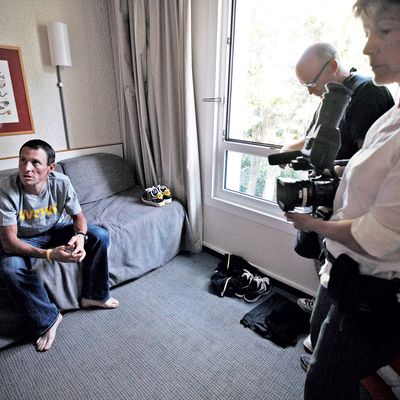
F.U., Lance Armstrong, and the bike you rode in on. Sorry, I had to get that off my chest. Now I can review Alex Gibney’s engrossing documentary, The Armstrong Lie, in a more objective manner. I should add that many people at the preview screening were muttering their own variations of “F.U., Lance Armstrong,” though it didn’t feel cathartic. There was too much free-floating creepiness. Gibney spent most of his time with his subject during the 2009 Tour de France “comeback,” when Armstrong was still lying his ass-face off. As an embarrassingly obvious liar, I am constantly fascinated by how others do it, and Gibney gives you many opportunities to study a master. The “tell,” I think, is that Armstrong’s face freezes and his eyes go dead when he says he has never doped. But then, his face often freezes and his eyes go dead in normal conversation. Which means he’s usually lying, which means — and I believe that Gibney intends to demonstrate this — that truth for Armstrong is relative and that what we call Lie-Land he calls home. And home is where he hangs his hat—but never his head.
Gibney puts himself at the center of the doc, which is unusual. In voice-over, he says he began shooting in 2009 and was more or less in bed with Lance. He was there to document Armstrong’s return to cycling after beating testicular cancer and the would-be amazin’ victory that ended badly for our protagonist, with Alberto Contador giving Lance a long “Eat my dust” look across his handlebars and showing him his receding derrière. Gibney would have mentioned the controversies, of course. He could hardly have left out the press conference in which Armstrong reams out Paul Kimmage for writing that “the cancer” had returned to cycling, meaning Armstrong. “You are not worth the chair you’re sitting on,” says Armstrong, looking Kimmage in the eye. And you can sympathize a little with his umbrage: Kimmage was hitting below the belt of a man who is presumably still tender down there — as well as justly proud of the hundreds of millions he has generated for sick children. The sympathy evaporates, though, when Gibney considers the hundreds of millions he generated for himself and a whole sleazy cabal that reached all the way to the upper administrative echelons of the sport — while simultaneously helping to ostracize cyclists he taught how to dope in the first place.
Anyway, Gibney put that 2009 footage aside until professional cycling was suddenly shocked, shocked by evidence of Armstrong’s doping and stripped him of his seven titles—whereupon Lance came semi-clean to Oprah, who has difficulty asking follow-up questions of people nearly as rich as she is. The Armstrong Lie jumps around in time. Now we’re in 2013, now 2009. Now we’re in the nineties, watching Lance’s rise from a fatherless Texas hothead to a smoothie who’d ride away with the big titles and then home to Sheryl Crow — while wise onlookers like David Walsh wrote that something smelled to heaven. The chronology is confusing at times, but the film is never not fascinating. I’m bound to admit that a skeletal, post-cancer Armstrong getting back on his bike and slowly, agonizingly into condition is more impressive than Rocky Balboa punching dead slabs of cow, and that if athletic prowess were measured simply by the will to subject oneself to anything, Armstrong is indeed a champion. Gibney also provides an education — if you want it — on blood oxygen levels and their adjustment via dope and transfusions. Lance’s doctor was named Ferrari, and if that wasn’t a clue to why he’d suddenly go so fast, I don’t know what is.
Back to that lying. Professional sports is now a mountain of asterisks — the honest ones, the ones who don’t dope, leave well below its peak, their names unknown to us—and Armstrong is its troll king. He can say, “I lied,” and still lie (the film strongly implies) about doping during the 2009 Tour. He can lie, I’m convinced, because he fundamentally believes that his lies elevated him to a different sphere than the rest of us mortals, and that he breathed the higher air. When he tells Gibney “I can sleep at night,” he’s not, for once, lying.
This review was originally published in the Nov. 11, 2013 issue of New York magazine.


